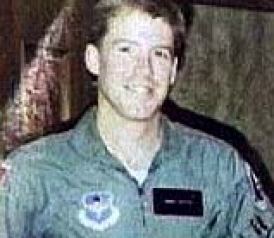Years of service 1991–1997 Name Craig Button | ||
 | ||
Allegiance United States of America Unit 355th Fighter Wing, Twelfth Air Force | ||
Craig David Button (24 November 1964 – 2 April 1997) was a United States Air Force pilot who died when he crashed an A-10 Thunderbolt II aircraft under mysterious circumstances on 2 April 1997. During the incident, Captain Button inexplicably flew hundreds of miles off-course without radio contact, appeared to maneuver purposefully and did not attempt to eject before the crash. His death is regarded as a suicide because no other hypothesis explains the events. His aircraft carried live bombs which were never recovered. It took three weeks to find the crash site. During that time, there was widespread public speculation about Button's intentions and whereabouts.
Contents
- Family
- Early life
- Air Force career
- Events of 2 April 1997
- Search and recovery
- Status of the Mk 82 bombs
- References

Family
Button's father, Richard Button, was a retired Air Force lieutenant colonel. His mother, Joan Button, was a devout Jehovah's Witness. According to a letter written by Button, she raised him "to think that joining the military is wrong." She did not allow Craig to wear his college AFROTC uniform at home. His half-sister, Susane Button, reported that his mother had wanted him to leave the military.
Hurlburt Field at Eglin Air Force Base in Florida (home of the Air Force Special Operations Command) is named after Button's uncle, Donald Wilson Hurlburt, who was a B-17 pilot in World War II.
Early life
Button graduated from Long Island's Wantagh High School in Wantagh, New York. He began flying at age 17 and aspired to be a professional pilot. He was described as "polite", "quiet" and a "perfectionist" who "rarely drank and never smoked." One of his instructors remarked that his shoes were always shined. His next-door neighbor growing up reports that he was "a ridiculously hard worker."
Air Force career
Button was commissioned through the Air Force ROTC program at New York Institute of Technology in Old Westbury, New York, where he received a degree in aerospace engineering in 1990. He spent four years at Laughlin Air Force Base in Texas as a T-37 first assignment instructor pilot (FAIP) before transferring to the A-10 at Davis–Monthan Air Force Base in Arizona. He had been an Air Force pilot for five years before the crash.
Events of 2 April 1997
Captain Button took off in his single-seat A-10 Thunderbolt II attack aircraft on a training mission with two other A-10s from Davis-Monthan Air Force Base in Tucson, Arizona. His jet was armed with four Mk-82 bombs, 60 magnesium flares, 120 metal chaff canisters and 575 rounds of 30-millimeter ammunition. This training mission would have been the first time Captain Button dropped live ordnance.
Near Gila Bend, Arizona, after being refueled in-flight, Button unexpectedly broke formation. He flew in a northeasterly direction towards the Four Corners area of Colorado, New Mexico, Arizona and Utah. His jet was spotted numerous times by observers on the ground. One observer, an off-duty pilot, said the jet appeared to maneuver around bad weather. This observation suggested to the Air Force that the aircraft was being flown manually and purposefully. The flight was tracked by radar in Phoenix, Albuquerque and Denver. But because Button's transponder was turned off, the aircraft was only tracked, not identified. It was only after analyzing radar data later that investigators were able to track Button's flight.
The jet zig-zagged near the end of its flight. It was last spotted in the air about 100 miles (160 km) west of Denver. The jet impacted terrain about 15 miles (24 km) SW of Vail, Colorado, on Gold Dust Peak (39°28′44″N 106°35′40″W) in a remote part of Eagle County. The Air Force concluded the jet probably had two to five minutes of fuel remaining when it crashed. The impact occurred at about 13,200 feet (4,000 m) of elevation, just 100 feet (30 m) below the summit. The debris field was over a quarter-mile-square area (0.64 km2). Pieces of the canopy and cockpit went over a ridge.
Search and recovery
The search for the crash site was conducted by the US Air Force, Colorado Air National Guard and the Civil Air Patrol. A U-2 reconnaissance plane from Beale Air Force Base in California overflew the area and identified five possible sites. Twenty days after Button's aircraft disappeared, an Air Force TH-53 helicopter spotted metal fragments in the snow on Gold Dust Peak. Steep terrain, bad weather, high winds, deep snow, rock slides and avalanches hampered access to the site. Rodents were even found to be chewing through the ropes of recovery personnel. It was several more days before the wreckage was confirmed to be Captain Button's missing A-10. It took another four months to recover the human remains.
Status of the Mk-82 bombs
The four 500-pound Mk-82 bombs have not been found despite an exhaustive search involving metal detectors and ground-penetrating radar. The bombs were designed to survive a crash and the Air Force expected to find them at the site. Furthermore, the aircraft's bomb racks were recovered in the wreckage, and they indicated that the bombs had not been released. Yet, more than four dozen witnesses reported hearing loud explosions in Northern Arizona and also near Telluride and Aspen in Colorado. However, no evidence was found to support the idea that Button released the weapons where the explosions were heard. The Mk-82 bombs can throw fragments more than a mile (1.6 km), and the crash site was less than 4000 feet (1.2 km) from a deep alpine lake.
